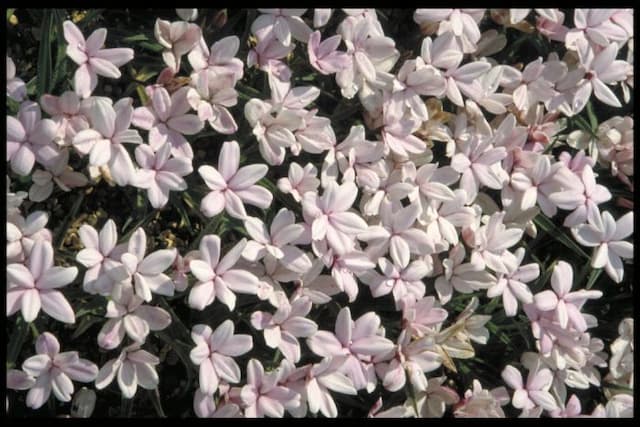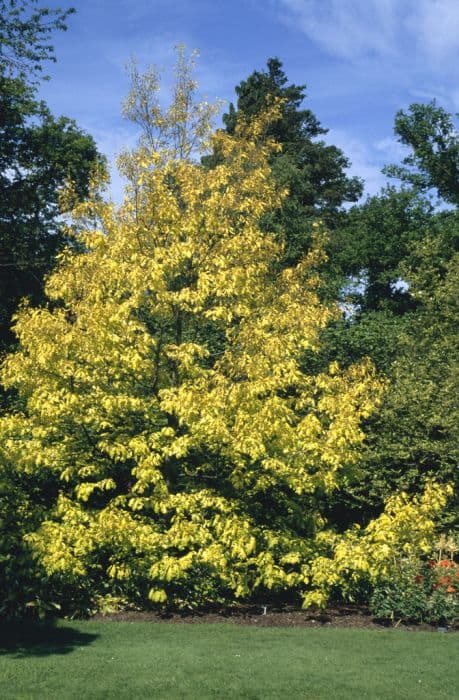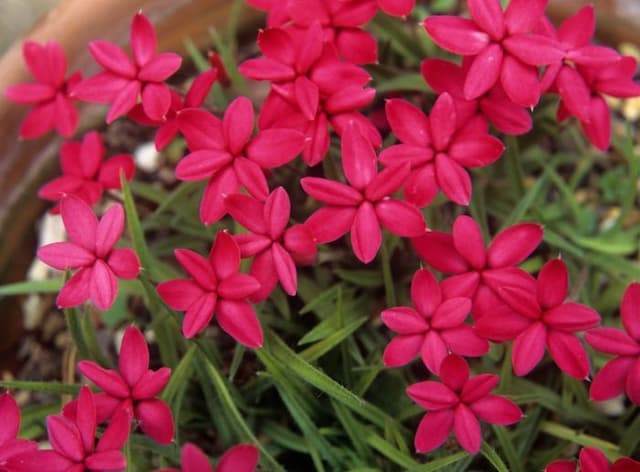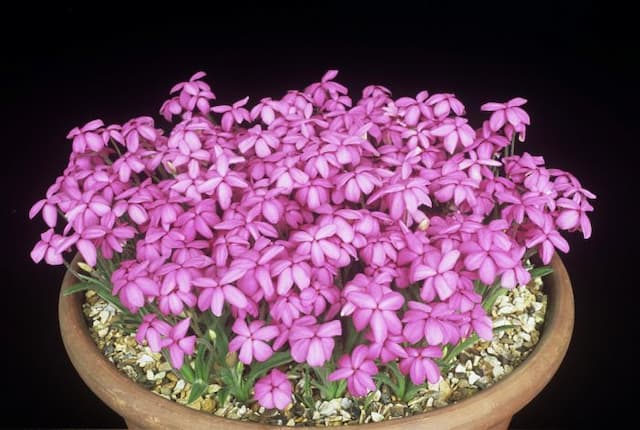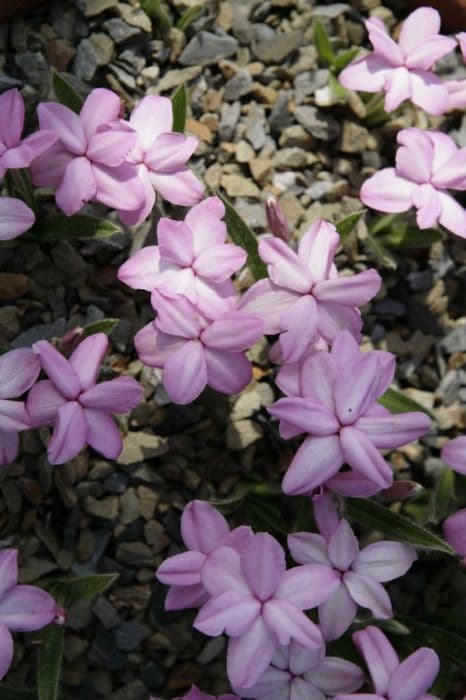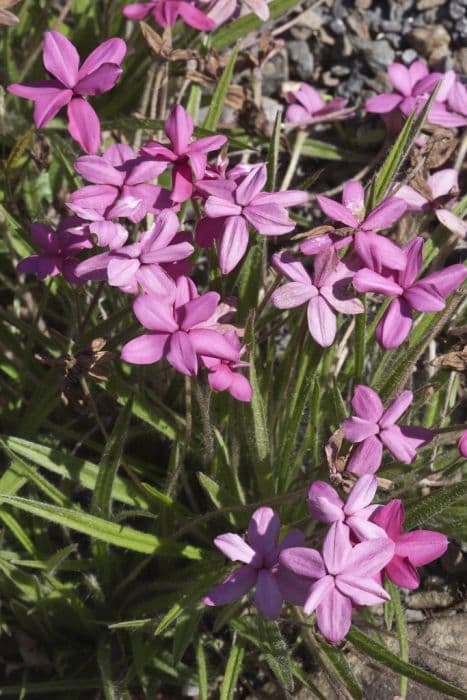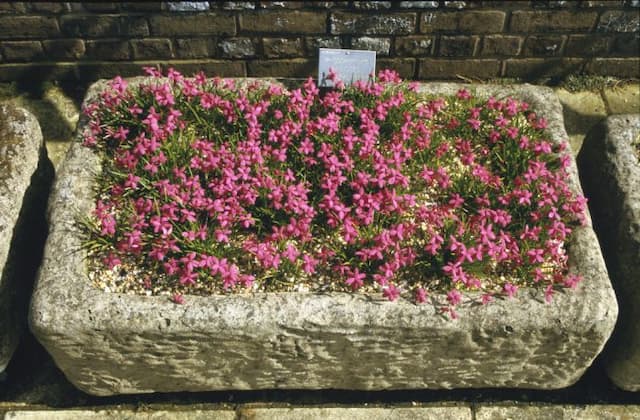Rhodoxis Fairytale × Rhodoxis Fairytale = 'Hil200802' (PBR)
![rhodoxis [Fairytale]](/_next/image?url=https%3A%2F%2Fplants-admin.emdemapps.com%2Fimages%2Fplants%2F%2Fimages%2F604b54204420d.png&w=3840&q=75)
ABOUT
× Rhodoxis Fairytale = 'Hil200802' (PBR) is a charming perennial that presents a delightful display of star-shaped flowers. These blooms exhibit a rich color palette ranging from deep pink to mauve, often with a lighter or darker eye at their center, adding a captivating contrast. The petals are slightly overlapping and may exhibit a subtle gradient in hue from the edges towards the middle. The foliage of the plant is a lush green, forming a dense mound of narrow, grass-like leaves that create a beautiful backdrop for the striking flowers. The leaves themselves may have a slight arch, contributing to the plant's overall graceful presentation. As a hybrid, × Rhodoxis Fairytale has a well-structured form that adds to its ornamental appeal, making it a popular choice for garden borders, containers, or as a ground cover where it can showcase its floral carpet effect. The plant is known for its resilience and can often withstand a variety of growing conditions, which along with its alluring appearance, makes it a favored addition to many gardens. Its long blooming period ensures a lasting display of color and beauty, beckoning the attention of onlookers and pollinators alike throughout the flowering season.
About this plant
 Names
NamesFamily
Hyacinthaceae.
Synonyms
Pink Fairy, Rose Lily.
Common names
× Rhodoxis Fairytale = 'Hil200802' (PBR)
 Toxicity
ToxicityTo humans
The plant in question, × Rhodoxis Fairytale, commonly referred to as Rhodoxis or Rose Lily, does not have specific toxicity information readily available for humans. Given the general lack of prominent toxicity found within its related genera, it is not likely known to be significantly toxic to humans. However, absence of known toxicity does not necessarily mean the plant is safe to consume. If accidental ingestion were to occur, it is advisable to monitor for gastrointestinal discomfort or allergic reactions and consult a medical professional, especially if any adverse symptoms manifest.
To pets
For pets, the × Rhodoxis Fairytale, also known as Rhodoxis or Rose Lily, is not widely known to be toxic. Since comprehensive information about its pet toxicity is lacking, it is prudent to exercise caution and prevent pets from ingesting this plant. While there may not be any well-documented cases of toxicity, any ingestion by pets should be observed for signs of gastrointestinal upset or unusual behavior, and a veterinarian should be consulted if any adverse symptoms arise after ingestion.
 Characteristics
CharacteristicsLife cycle
Perennials
Foliage type
Deciduous
Color of leaves
Green
Flower color
Pink
Height
0.5 feet (15 cm)
Spread
0.5 feet (15 cm)
Plant type
Bulb
Hardiness zones
6
Native area
South Africa
Benefits
 General Benefits
General Benefits- Attractive Aesthetics: × Rhodoxis Fairytale produces appealing pink flowers that can enhance the visual appeal of gardens and landscapes.
- Compact Growth: It has a compact growth habit, making it suitable for small gardens, rockeries, and containers.
- Low Maintenance: This plant typically requires minimal upkeep, making it a convenient choice for busy gardeners.
- Drought Tolerance: It is relatively drought-tolerant once established, reducing the need for frequent watering.
- Long Blooming Period: Provides a long season of interest with its flowers blooming for an extended period from spring to summer.
- Cold Hardy: It's cold hardy, which makes it suitable for growing in a variety of climates, withstanding cooler temperatures well.
- Attracts Pollinators: The flowers can attract pollinating insects, contributing to the health of the garden ecosystem.
 Medical Properties
Medical PropertiesThis plant is not used for medical purposes.
 Air-purifying Qualities
Air-purifying QualitiesThis plant is not specifically known for air purifying qualities.
 Other Uses
Other Uses- Pot-pourri: Dried petals of the Rhodoxis can be added to pot-pourri mixtures to provide a delicate fragrance and enhance visual appeal.
- Art Supplies: Pressed flowers of the Rhodoxis can be used in various artistic endeavors such as making bookmarks, greeting cards, or decorating picture frames.
- Photography Subject: With its beautiful blooms, Rhodoxis can serve as an excellent subject for photography, contributing to botanical and artistic compositions.
- Educational Tool: Rhodoxis can be used in educational settings to teach concepts like plant biology, hybridization, and genetics due to its hybrid nature.
- Culinary Decoration: The petals of Rhodoxis, if non-toxic, can be used to decorate salads and desserts, adding color and elegance to dishes.
- Wedding Decor: Rhodoxis flowers can be incorporated into wedding bouquets, boutonnieres, or table arrangements for a natural and romantic touch.
- Fairy Gardens: Because of its charming appearance, Rhodoxis can be included in fairy garden designs, adding a touch of magic and whimsy to miniature landscapes.
- Crafting: Rhodoxis flowers can be used in crafting, for instance by embedding them into candles or creating floral resin jewelry.
- Fabric Dyeing: The pigments from Rhodoxis flowers could potentially be used in natural fabric dyeing processes for unique color effects.
- Gift Plants: As a compact and attractive plant, Rhodoxis can be potted and given as a thoughtful living gift for various occasions.
Interesting Facts
 Feng Shui
Feng ShuiThe plant_name is not used in Feng Shui practice.
 Zodiac Sign Compitability
Zodiac Sign CompitabilityThe plant_name is not used in astrology practice.
 Plant Symbolism
Plant Symbolism- Love and Admiration: Rhodoxis, also known as red star, is often associated with sentiments of love and admiration. The vibrant colors of its flowers can symbolize a strong and passionate affection.
- Charm and Attraction: The star-like shape and striking appearance of the red star plant may represent charm and the ability to attract positive attention.
- Beauty and Grace: Rhodoxis Fairytale, with its delicate blooms and elegant form, can be symbolic of natural beauty and gracefulness.
- Resilience and Survival: These plants are able to thrive in tough conditions, which can make them a symbol of resilience and the ability to survive challenges.
 Water
WaterThe plant commonly known as Rhodoxis or Fairy Tale Star should be watered moderately, ensuring that the soil is kept moist but not waterlogged. During the growing season, which is spring and summer, watering should be done once the top inch of soil feels dry, approximately every 7 to 10 days, with around 16 ounces of water per session. During the dormant season, in fall and winter, reduce watering to every two to three weeks or just enough to prevent the soil from completely drying out. Always check the moisture level of the soil before watering to avoid over-saturation.
 Light
LightFairy Tale Star thrive in bright, indirect sunlight. A spot that receives partial shade with morning sun and afternoon protection is ideal. Avoid placing the plant in direct afternoon sunlight, which can scorch the leaves, or in deep shade, which can stunt growth and reduce flowering. East or north-facing windowsills are typically excellent locations for these plants.
 Temperature
TemperatureFairy Tale Star prefer temperate conditions, thriving in temperatures between 50°F and 75°F. They can survive brief periods of temperature extremes, but long exposure to temperatures below 40°F or above 80°F should be avoided to prevent damage. The ideal temperature for promoting growth and flowering is within the recommended range, without significant fluctuations.
 Pruning
PruningFairy Tale Star plants may need occasional pruning to remove dead or yellowing leaves, which helps to promote healthy growth and appearance. Pruning is best done in the late winter or early spring before new growth begins. This plant generally requires light pruning, with careful removal of any spent flowers or damaged foliage to encourage a tidy form and more blooms.
 Cleaning
CleaningAs needed
 Soil
SoilThe best soil mix for Rhodoxis Fairytale, commonly known as Pink Fairy Lily, is a well-draining medium with equal parts of loam, sand, and peat. The soil pH should be slightly acidic to neutral, ranging from 6.0 to 7.0.
 Repotting
RepottingPink Fairy Lily should typically be repotted every 2 to 3 years or when it outgrows its current pot. Spring is the best time for repotting to allow the plant to establish during the growing season.
 Humidity & Misting
Humidity & MistingPink Fairy Lily prefers moderate humidity levels, around 40-60%, which is typical of indoor environments. Avoid placing the plant in excessively dry or damp conditions to maintain optimal growth.
 Suitable locations
Suitable locationsIndoor
For indoor growth, place Pink Fairy Lily in bright, indirect light and keep soil moist.
Outdoor
Grow Pink Fairy Lily outdoor in partial shade and protect from strong winds.
Hardiness zone
7-9 USDA
 Life cycle
Life cycleThe × Rhodoxis Fairytale = 'Hil200802' (PBR), commonly known as Hybrids of Rhodohypoxis and Hypoxis starts its life as a seed, which germinates in favorable conditions of warmth and moisture, typically in spring. After germination, it develops into a seedling with initial roots and leaves, gradually forming a small bulb-like corm from which it draws nutrients. As it matures, foliage emerges, displaying grassy leaves and followed by the distinctive star-shaped flowers in hues of pink or white, blooming throughout the summer months. Post flowering, the plant enters a dormant phase during the colder months, where the foliage dies back and the corm survives underground. Each subsequent spring, the plant resumes growth from the corm, repeating its growth and blooming cycle. The plant continues this annual cycle for several years, after which the corms can be divided, and new plants can be propagated to continue the lineage.
 Propogation
PropogationPropogation time
Spring-Early Summer
Propogation: The × Rhodoxis Fairytale, also known as the Fairy Tale Star, is a delicate and ornamental hybrid plant that is commonly propagated through division, which is the most popular method. During the plant's dormancy period, which typically occurs in the early spring or late fall, the clumps of rhizomes or bulbs can be gently separated. Carefully unearth the clump and use a clean, sharp knife to slice through the rhizomes, ensuring that each new section has at least one growth point or bud. These sections can then be immediately replanted into well-draining soil and watered lightly to encourage root development. It is important to maintain consistent moisture without waterlogging the plants during the initial stages of growth. By using this method, gardeners can effectively expand their collection of Fairy Tale Stars or propagate new plants for sharing.

